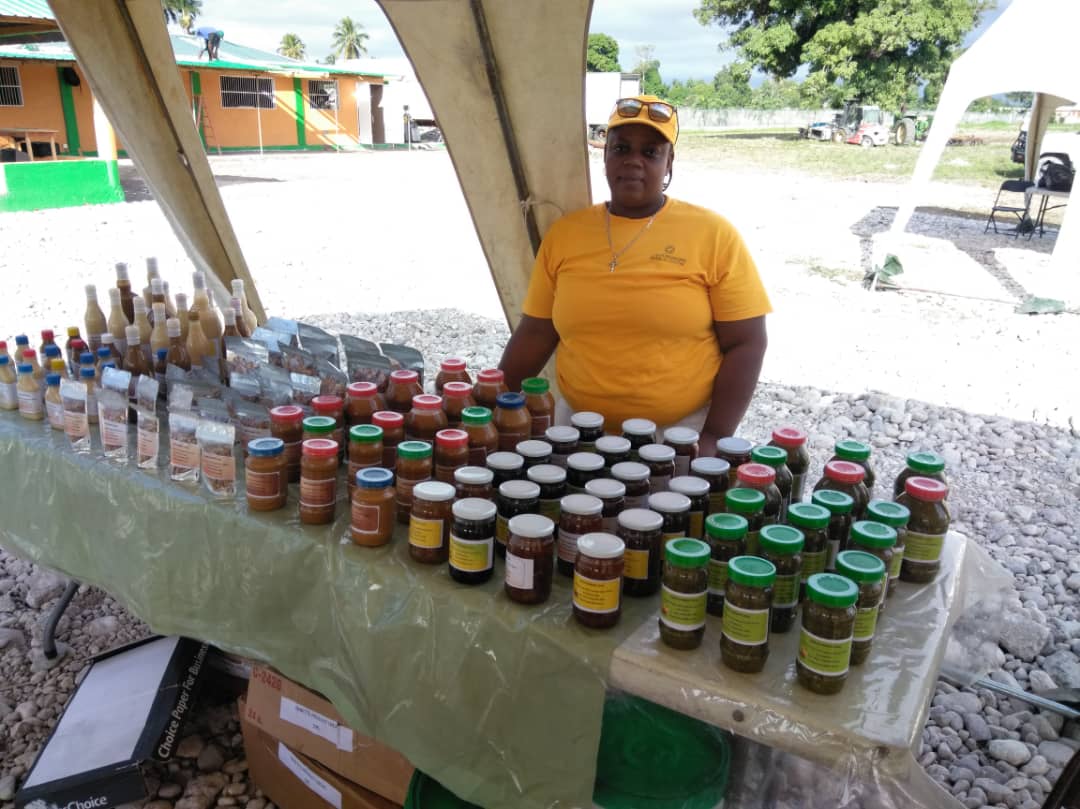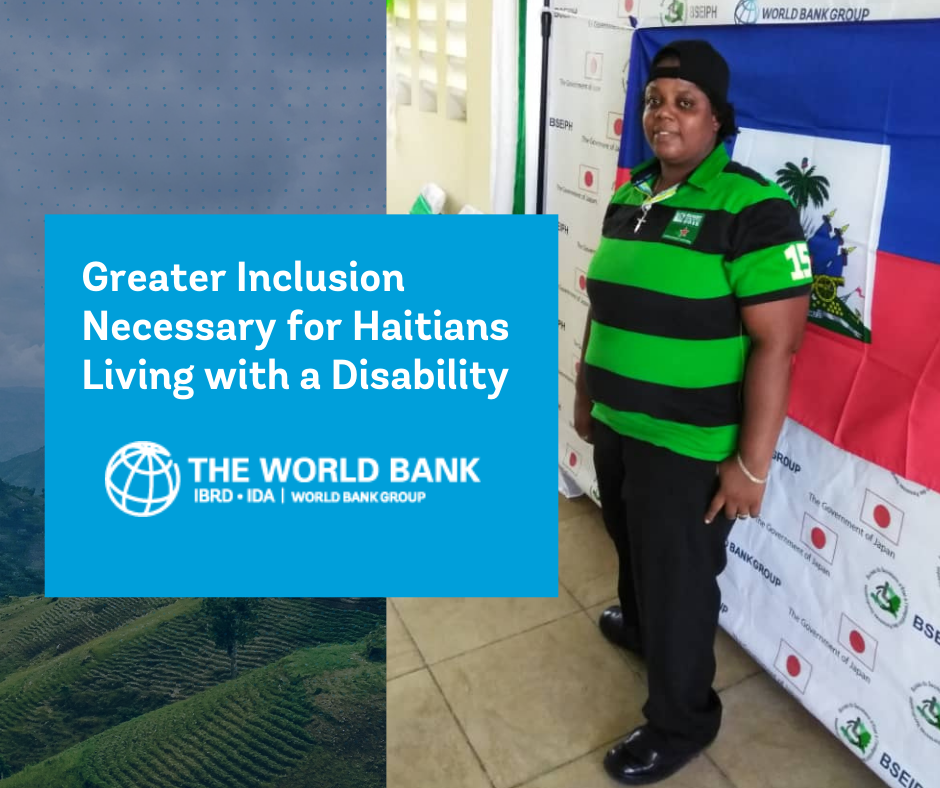According to Rose Dinette Joseph, a 40-year-old young woman, living with a disability should not be an obstacle to achieving her personal and professional goals. However, for this Haitian woman born with congenital equinovarus (club foot), the reality is quite different. Her life is filled with ridicule from classmates, relatives and neighbors, social obstacles and inadequate infrastructure to accommodate her disability. Rose Dinette is not intimidated by these significant limitations and the opinions of others; in fact, these obstacles have driven her to fight for a better living environment for people with disabilities.
Increasing inclusion of people with disabilities is essential to building a more equitable society in Haiti. Although disabilities are recognized to affect a significant portion of Haiti’s population, there are no recent, accurate estimates of the number of people with disabilities in Haiti. The EMMUS-VI survey (2016-2017) estimated that approximately 4% of Haiti’s population aged 5 and over have some type of disability.

According to the World Bank’s report “Disability and Inclusion in Latin America and the Caribbean,” released in December 2021, people with disabilities are over-represented among groups at risk of falling into poverty. The report concludes that people with disabilities are more likely to live in informal settlements, spend less time in school, and be excluded from the labor market. It finds that, particularly in developing countries, people with disabilities often have limited access to services and lack the proper infrastructure to fully participate in society.
In Haiti, the prospects for full social inclusion for persons with disabilities are extremely difficult due to the high socio-economic vulnerability of the population in general. Haiti has the lowest GDP per capita in Latin America and the Caribbean and is ranked 170th out of 189 countries on the 2020 United Nations Human Development Index.
Lack of access to social services is a barrier to inclusion
As part of the ongoing expansion of the social register SIMAST[1] The Office of the Minister for the Integration of Persons with Disabilities (BSEIPH) conducted a survey using the new disability module in about 60 municipalities in Haiti to register 53,783 people living with disabilities in Haiti.
According to the data collected, disabilities related to physical mobility are the most common in Haiti, affecting 43% of respondents. Those with significant problems with vision, cognition and the inability to care for themselves represent between 21% and 27% of those enrolled. Hearing and communication difficulties affect 11% and 14% respectively of the disabled people surveyed.
These data show that some people may have more than one type of disability: on average, people with disabilities report being affected by 1.4 of the disability types considered.[2]
While the overall literacy rate in the country is 62 percent, the survey found that less than 30 percent of respondents with disabilities can read and write. This trend is even more severe for women with disabilities, who are less than 23 percent literate. Moreover, certain groups appear to be particularly excluded from education, with less than 14 percent of hearing-impaired women being literate and write.
The study also revealed that only 3.8% of the surveyed population received disability benefits (allowances, grants, pensions). Despite the fact that around 96% of the population is exposed to natural disasters, Rose Dinette regrets that there is not enough special attention given to disabled people who are evacuated to emergency shelters. “We started the organisation Volunteer South for the protection of disabled people. When disasters strike, we support the Civil Protection Department to ensure that disabled people receive support in safe places, adapted to their reduced mobility.”
Barriers to the world of work
Data collected in the survey revealed that more than three-quarters of working-age people living with a disability are not working due to their health or disability. Only 2.6% of respondents are in salaried employment. Most of the respondents said they earn an income through entrepreneurship.
Rose Dinette’s story reflects this harsh reality. “After I finished my degree in public administration, I applied for a few jobs, but it didn’t work out,” she recalls. Now Rose Dinette volunteers as a project secretary for an organization that supports women with disabilities. She reports that many people with disabilities are denied work because of their physical limitations. “Sometimes they are employed by charities without the employer taking into account their true capabilities.”
Outlook
Throughout Latin America and the Caribbean, people with disabilities continue to face widespread discrimination and barriers that limit their personal development and social mobility. In Haiti, people with disabilities face extreme vulnerability, very high rates of illiteracy, poor integration into the working world and great needs in terms of technical assistance.
The National Policy for Promotion of Social Security (PNPPS), adopted in 2020, recognizes the vulnerability of persons with disabilities. Within this framework, the World Bank-funded Adapted Social Security Strengthening (ASPIRE) project will finance a new flagship safety net program run by the Ministry of Social and Labor in Cré-lé-Ciméne, Grande Anse. The project will provide cash transfers to the most vulnerable households, including those with persons with disabilities, supporting them with regular cash transfers as well as accompanying measures that address health, nutrition, and financial inclusion issues.
Beyond collecting the SIMAST survey data, BSEIPH also implemented a series of activities to promote access to the labor market through vocational training and placement services, and share knowledge through outreach activities such as communication campaigns. The first 127 people, including Rose Dinette, were also trained in cooking, agriculture, processing and motorcycle repair. The project aims to provide them with a way to increase their income and gradually make them economically independent.[3].
“Unless you come from a wealthy family, the only option for social mobility for people with disabilities in Haiti is to start a business. For example, after I was trained in agro-processing, I started a business that allowed me to diversify my income sources,” says Rose Dinette.
Overall, these new data are beginning to fill critical knowledge gaps, improving our understanding of the living conditions of people with disabilities and highlighting their extreme vulnerability. People with disabilities are often excluded from services, which results in lower rates of literacy and labour market participation, and less access to the technical assistance and benefits they need. Chains of crises further exacerbate the vulnerability of these populations. In this context, it is crucial to continue enrollment in social registers and to promote their resilience and inclusion through programmes that address their specific vulnerabilities.

[1] Ministry of Social Affairs and Labor Information System, http://infopage.simast.info/
[2] The study was based on methodology developed by the Washington Group.
[3] This project was funded through the Japan Policy and Human Resources Development Fund (PHRD).

